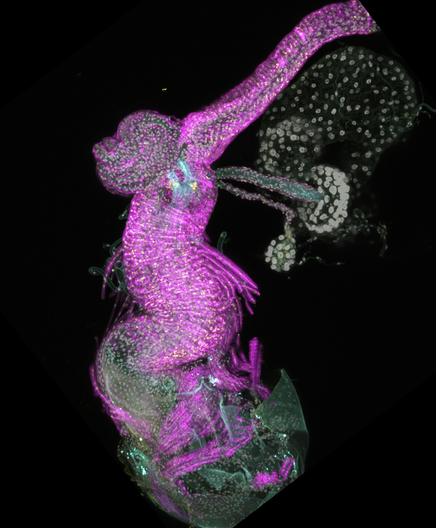Thank you to Andy Fell for this press summary of our work! https://www.ucdavis.edu/news/invisible-anatomy-fruit-fly-uterus
Evolution of structural color in butterflies🦋🌈 Gene expression coevolution in female reproductive tissues 🧬 . Postdoc | UC Davis.
We also found that any way we look— gene diversity, volume, specificity—females express a lot of “Seminal Fluid Protein” genes, especially within their sperm storage organs. This recontextualizes popular ideas that SFPs manipulate females to benefit males 3/n
We found lots of fun surprises that may be typical of female biology in many species. For example, previously imperceptible anatomy within the uterus, defined by cell populations with different secretory and hormone-related gene expression activity. 2/n
Our paper identifying and characterizing cell types in the Drosophila female reproductive tract (uterus, sperm storage organs, female-limited glands) is out! 1/n https://doi.org/10.1073/pnas.2409850121
Friends, everybody is getting Covid again, okay please mask, please get your booster and flu shot, and *before* you test positive check out this program for free testing, telehealth, and treatment from the NIH
https://www.test2treat.org/s/?language=en_US
Hey everyone, if you haven’t gotten your updated COVID-19 vaccine yet, right now is the perfect time!
It takes a couple of weeks to get full protection after being vaccinated, so it's advisable to get it a while before Thanksgiving. Also, the winter surge usually starts at Thanksgiving.
The vaccines are covered by insurance, or the CDC's bridge access program if you are uninsured.
You can find a place to get vaccinated near you here: https://www.vaccines.gov
Your data needs a README file!
Dryad Senior Curator Bryan Gee breaks down our top tips for crafting README files that will help you and others interpret and reuse your data in this 1-hour webinar.
Watch the recording now 📽️ ➡️ https://youtu.be/A5HqsamqpTo
This is part of JEB’s Centenary series. They’re doing a cool thing interviewing Early Career authors: https://journals.biologists.com/jeb/pages/ECR-spotlight Fun to see some friends on the list! My interview is here: tinyurl.com/4872scnf
8/n
You can use our new database of butterfly structural colors! On Dryad here: doi.org/10.5061/dryad.qnk98sfnx
The dataset has extra info not presented in the paper, e.g. whether structures were in cover vs ground scales, any co-occurring pigments, refs to original studies, notes on all putative structures uncovered by our lit review with incomplete data but maybe worth further investigation, and more 7/n
This is a hybrid meta-analysis and literature review. We review how butterflies produce photonic nanostructures– this includes their development, genetic control, and evolution. You may be interested if you are using biomimetic engineering applications to manipulate light or you’re looking for project ideas / interesting knowledge gaps. We note a bunch e.g. characterizing larval colors and understudied taxa; quantifying morphology variation between individuals and populations; and more 6/n
All the data on a phylogeny! Patterns that stand out to me: blue is also the most common phylogenetically, and most of the oddball structures occur in understudied butterfly families. The least-studied groups we highlight may be the best place to look for novel photonic nanostructures 5/n
nanostructure types make different colors. Thin films, the simplest structure, are the only type that makes all the colors but are least bright. Overall, blue is common and made by every major structure type. Long-wavelength colors are super rare and often poor quality dim or need co-occurring pigments. We discuss why this might be and how it complements the color range that butterfly chemical pigments produce. 4/n
Consistent with previous reviews, I found 7 major morphological categories of optical nanostructures in butterflies, plus a few uncommon / weird structures. Here, a summary of how the nanostructures compare to a basic butterfly scale: 3/n
Structural color–in which iridescent colors are produced by optical nanostructures rather than by color from chemical pigments–is common in butterfly wings. As a pandemic project, I compiled data for all documented butterfly structural colors that I could find: >300 nanostructures spanning a century of research. I used these data to ask whether different types of nanostructures make different colors or occur in different butterfly clades 2/n
Some highlights from my paper with Nipam Patel, out now in Journal of Experimental Biology:
doi.org/10.1242/jeb.245940
#evolution #ecoevo #evodevo #photonics #color 1/n
New preprint - my work with @gcbias using the wavelet transform to decompose the genomic & temporal scale of processes shaping the evolution of hybridizing populations: https://www.biorxiv.org/content/10.1101/2023.05.25.542345v2
Loved seeing this last night - bats on the radar as they head out for their evening meals. How many circles of bats emerging can you count? (Attachment is a video of weather radar of the #CentralTexas area, showing many expanding circles around areas where bats roost during the day.) #Texas #Austin #bats #radar #nature #ecology
